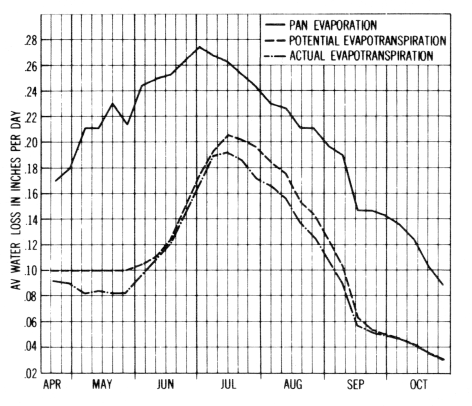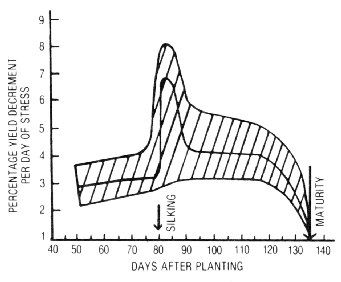
NCH-18

D.G. Baker, University of Minnesota R.V. Crow, Funk Seeds, Inc. IA
R.F. Dale, Purdue University Rich Feltes, Continental Grain Company, IL
D.G. Hanway. University of Nebraska P.R. Henderlong, Ohio State University
J.D. McQuigg, University of Missouri
Weather is seldom "normal." Much of the time, it's either too wet or too dry, too hot or too cold for optimum corn growth. In some areas and under certain soil conditions, even average seasonal weather will produce stress in corn. Plant stress visually can be very obvious; but often it's so slight as to go unnoticed by the casual observer until the yield results are in!
Stress may result from a number of factors. A shortage of plant water is by far the most frequently occurring and detrimental one within the Corn Belt, particularly the western part. However, excess moisture will also create a stress situation.
Adverse soil moisture and temperature conditions in combination with nutrient deficiencies, diseases, insects, and weeds interact to create many different kinds of crop stress. And proper diagnosis of such stress under field conditions is not a simple matter.
Solar radiation can also be an interactive stress factor, in spite of its critical role in plant photosynthesis. For example, in controlled experiments, increased radiation has been shown to increase corn yields if other factors are kept adequate. However, under field conditions in the western Corn Belt, high radiation is often associated with low rainfall and high evaporative demand, resulting in moisture stress that becomes the dominant factor in affecting final corn yield.
Two of the western Corn Belt's best yield years (1981 and 1982) were also years with low solar radiation. Would higher radiation have increased yields because of greater photosynthetic activity or reduced yields because of greater moisture stress? Such questions can be answered only if one understands the interactive effects of the different weather parameters.
This publication describes the various weather-induced stress conditions that affect the corn plant during each of its growth stages. Discussed are how the conditions develop, how they may be identified, and what their individual and interactive effects might be on final grain yield. Suggestions for minimizing stress effects are also provided.
Soil moisture availability is determined by the interaction of four factors: (1) amount of moisture present in the soil, (2) characteristics of the soil profile, (3) moisture capacity of the crop and (4) demand for water by the atmosphere. Atmospheric demand is a function of the energy available (solar radiation), movement of moisture away from the evaporating surface (wind), dryness of the air (humidity), and air temperature or sensible heat level.
For crop moisture to be adequate, the available soil moisture must be more than sufficient to meet the atmospheric evaporative demand. On windy, hot, sunny days with low humidity, for instance, evaporation demand on a crop is high; and thus, a high amount of available soil moisture must be present if the crop is to avoid stress. Under cloudy skies, high humidity and cooler temperatures, on the other hand, atmospheric evaporative demand is low. Less water is needed to meet the demand, thus, plants can get by with lower amounts of avail- able soil moisture.
Figure 1 compares the 20-year average values of Class A pan evaporation, potential evapotranspiration (plant water use without stress) and actual evapotranspiration for Iowa. The figure shows that water use is low early in the season and reaches a peak in July. Average use at that time is almost 0.2 inch per day, and under high demand may exceed 0.3 inch per day. Moisture stress will interrupt plant growth and reproductive processes until the stress is removed and plant turgor restored.

In some soils, moisture stress can lead to a plant nutrient stress. For instance, the shallow depths where the fertilizer is placed will be dry under stress situations. Soil conditions that produce shallow plant root development also can cause nutrient stress, because fertilizer availability is often a problem under such conditions.
Stress in the period from planting to seedling emergence is usually related to either soil temperature, soil moisture, soil aeration conditions or the interaction among them. The most common stress imposed at this time is that of cold soil temperatures.
Corn planting typically begins in the Corn Belt when average air temperature is near 50 F and soil temperature at planting depth is around 55 F. However, optimum seed germination and emergence occur when air and soil temperatures reach 68-77 F, which is 15-25 degrees above the average planting date norms.
Cooler temperatures alone are not likely to impose a stress on the seedling, but only delay its emergence. Even frost and freezing temperatures should not cause a problem during preemergence. But wet weather added to cold temperatures following planting will favor development and activity of some soil pathogens that can produce disease stress in the young seedling.
Shortly after emergence, the corn plant shifts from dependence on food stored in the seed to that available in the soil. At this stage, stress due to moisture shortage seldom occurs, because spring rainfall is usually adequate and the plant's moisture requirement is very low basically only enough to get the permanent roots growing.
If the top few inches of soil become very dry when the plant is small, early growth problems will likely occur. However, some feel that moderate moisture stress during this period is actually advantageous, since such stress may encourage early-season root growth, which would prove beneficial later if moisture supplies become short. Further, a dry surface soil utilizes more of the solar energy to heat the soil.
Excess moisture in the early vegetative stages may retard early-season root development as well as create aeration-nutrition problems. Also, cool but above-freezing temperatures apparently have some detrimental effects at this time, but such effects are not well documented. Late-spring frost and freezing temperatures, however, can destroy a corn crop if the plant growing point has emerged above the soil surface, which usually occurs at the 6- to 8-leaf stage of growth. If the growing point is below the soil surface, there is seldom permanent injury because the growing point rarely freezes.
Dry matter production in corn plants is greatest when average daily soil temperature at the 4-inch (10-cm) depth is about 80 F. Since soil temperatures are usually lower than that in these early vegetative stages, low-temperature stress is often present, particularly during cold, wet springs.
The effect of early-season stress on the final corn yield is difficult to access. Although moisture stress reduces plant size, it has little effect on final yield if good crop production conditions prevail during the pollination and grain-filling periods.
Relationships between weather and yield are more significant in the late vegetative growth stages--i.e., the 3- to 4-week period up to silking. For much of the Corn Belt, this is normally the last week of June and first 3 weeks of July; in the south, this period comes earlier.
Average air temperatures during the late vegetative stages are frequently above 72-75 F, which is considered optimum for corn growth. If too much above, moisture stress may also occur. Under this dual moisture-temperature stress condition, vegetative growth will be reduced. Smaller plants in the population are further stunted; larger plants will also be affected but to a lesser degree. Overall, a final grain yield reduction of 2-3 percent per day of stress will result.
This is the most critical stage in corn development for any type of stress to occur. Combined moisture-temperature stress during the reproductive period can substantially reduce final grain yield.
Although separating the effects of these two stresses is difficult, most temperature stress conditions occur on high atmospheric-moisture-demand days--i.e., days when the daily mean temperature is above 77 F and the daily maximum is above 95 F, regardless of soil moisture conditions. However, the greatest potential yield reduction probably occurs from moisture stress during the silking process. Such stress delays silking and increases the time required for pollination. The result is that sometimes all the pollen may be shed before the silks emerge.
Either nutrient, pest or disease stress at the corn reproductive stages can also affect yield drastically. For instance, when moisture stress is combined with plant nutrient and temperature stress, final grain yield can be cut by up to 13 percent per day. Nutrient stress often happens during a drought, because the upper part of the soil where the fertilizer has been placed is dry and out of the active root extraction zone.
Grain filling and maturation occur in the last 50-60 days of the corn plant's growth cycle. Early in this period, any kind of severe crop stress can reduce final yield as much as 3-4 percent per day, with the reduction becoming less as the plants approach complete "black-layer" (physiological) maturity.
The greatest single threat to yields during grain-filling is frost or freezing temperatures before black-layer maturity. The corn crop normally reaches this point about 50 days after pollination in western portions of the Corn Belt but requires up to 60 days in the eastern areas.
If a crop is prematurely killed 10 days to 2 weeks (200 growing degree days) before black-layer maturity, a 4-5 percent grain yield reduction can be expected. If killed 3 weeks before physiologically mature, yield loss is 10-20 percent, with considerable reduction in grain quality. A crop killed by freezing temperatures 1 month before normal maturity (or 30-35 days after silking) is reduced in potential grain yield by 35-50 percent, and the grain is probably not marketable.
Figure 2 summarizes the likely relationships between corn grain yield reductions and moisture stress. The outer two lines represent the upper and lower limits of yield reduction determined from various experiments; the middle line is the average. Although experiments were not run to evaluate effects of stress occurring before 35-40 days after planting, experience indicates that yield reductions would be, at most, small. In fact, moderate stress may be beneficial, in that it induces early development of a good root system.

During germination, emergence and the early growth stages, soil moisture and soil temperature levels are critical factors. During the late vegetative growth period, crop moisture stress can reduce final grain yield up to 3 percent per day.
During the tasseling and silking, corn is very sensitive to stress. At that time, high seasonal temperatures combined with low soil moisture availability may reduce yields an average of 5 percent per day; under more severe temperature-moisture conditions, reductions can run over 10 percent per day; and under extreme stress. corn fertilization might not even occur, resulting in total crop failure.
After pollination and during the grain-filling period, corn becomes increasingly less sensitive to stress. In the early weeks of grain-filling, stress can cut final yield up to 5 percent per day; about 6 weeks after pollination, its effects decline rapidly.
As it relates to weather stresses, optimum planting date will vary from season to season. Therefore, the practice of planting corn as early as soil conditions permit may not be a wise one with respect to potential growing-season stresses. Perhaps a better recommendation is to avoid or at least minimize potential stresses by planting hybrids of different maturities over several planting dates. This will spread out the tasseling, silking, pollination and maturity dates within the given growing season.
RR 4/91
Cooperative Extension Work in Agriculture and Home Economics, State of Indiana, Purdue University and U.S. Department of Agriculture Cooperating. H.A. Wadsworth, Director, West Lafayette, IN. Issued in furtherance of the Acts of May 8 and June 30, 1914. It is the policy of the Cooperative Extension Service of Purdue University that all persons shall have equal opportunity and access to our programs and facilities.